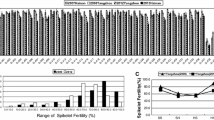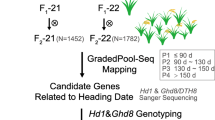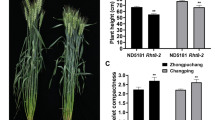Abstract
Hybrid breakdown (HB), a phenomenon of reduced viability or fertility accompanied with retarded growth in hybrid progenies, often arises in the offspring of intersubspecific hybrids between indica and japonica in rice. We detected HB plants in F8 recombinant inbred lines derived from the cross between an indica variety, Milyang 23, and a japonica variety, Tong 88-7. HB plants showed retarded growth, with fewer tillers and spikelets. Genetic analysis revealed that HB was controlled by the complementary action of two recessive genes, hwh1 and hwh2, originating from each of both parents, which were fine-mapped on the short arm of chromosome 2 and on the near centromere region of the long arm of chromosome 11, respectively. A comparison of the sequences of candidate genes among both parents and HB plants revealed that hwh1 encoded a putative glucose-methanol-choline oxidoreductase with one amino acid change compared to Hwh1 and that hwh2 probably encoded a putative hexose transporter with a six amino acid insertion compared to Hwh2. Investigation of the distribution of these alleles among 54 japonica and indica cultivars using candidate gene-based markers suggested that the two loci might be involved in develo** reproductive barriers between two subspecies.







Similar content being viewed by others
References
Bateson W (1909) Heredity and variation in modern lights. In: Seward AC (ed) Darwin and modern science, Cambridge University Press, Cambridge, pp 85–101
Bomblies K, Lempe J, Epple P, Warthmann N, Lanz C, Dangl JL, Weigel D (2007) Autoimmune response as a mechanism for a Dobzhansky-Muller-Type incompatibility syndrome in plants. PLoS Biol 5(9):1962–1972
Bomblies K, Weigel D (2007) Hybrid necrosis: autoimmunity as a potential gene-flow barrier in plant species. Nat Rev Genet 8:382–393
Brideau NJ, Flores HA, Wang J, Maheshwari S, Wang X, Barbash DA (2006) Two Dobzhansky-Muller genes interact to cause hybrid lethality in Drosophila. Science 314(5803):1292–1295
Burke J, Arnold ML (2001) Genetics and the fitness of hybrids. Annu Rev Genet 35:31–52
Causse MA, Fulto TM, Cho YG, Ahn SN, Chuncongse J, Wu K, **ao J, Yu Z, Ronald PC, Harrington SE, Second G, McCouch SR, Tanksley SD (1994) Saturated molecular map of the rice genome based on an interspecific backcross population. Genetics 138:1251–1274
Cavener DR (1992) GMC oxidoreductases. A newly defined family of homologous proteins with diverse catalytic activities. J Mol Biol 223:811–814
Chin JH, Kim JH, Jiang W, Chu SH, Woo MO, Han L, Brar D, Koh HJ (2007) Identification of subspecies-specific STS markers and their association with segregation distortion in rice (Oryza sativa L.). J Crop Sci Biotech 10(3):175–184
Christie P, MacNair MR (1984) Complementary lethal factors in two North American populations of the yellow monkey flower. J Hered 75:510–511
Coyne JA (1992) Genetics and speciation. Nature 355:511–515
Dobzhansky TH (1936) Studies on hybrid sterility. II. Localization of sterility factors in Drosophila pseudoobscura hybrids. Genetics 21:113–135
Fukuoka S, Namai H, Okuno k (1998) RFLP map** of the genes controlling hybrid breakdown in rice (Oryza sativa L.). Theor Appl Genet 97:446–499
Fukuoka S, Newingham MCV, Ihitiaq M, Nagamine T, Kawase M, Okuno K (2005) Identification and map** of two new loci for hybrid breakdown in cultivated rice. Rice Genet Newsl 22:29–31
Futuyma DJ (1986) Evolutionary biology. 2nd edn. Sinauer, Sunderland
Iida K, Cox-Foster DL, Yang X, Ko WY, Cavener DR (2007) Expansion and evolution of insect GMC oxidoreductases. BMC Evol Biol 7:75–85
Johnson DA, Hill JP, Thomas MA (2006) The monosaccharide transporter gene family in land plants is ancient and shows differential subfamily expression and expansion across lineages. BMC Evol Biol 6:64
Kosambi DD (1944) The estimation of map distances from recombination values. Ann Eugen 12:172–175
Kubo T, Yoshimura A (2002) Genetic basis of hybrid breakdown in a japonica/indica cross of rice, Oryza sativa L. Theor Appl Genet 105:906–911
Kubo T, Yoshimura A (2005) Epistasis underlying female sterility detected in hybrid breakdown in a japonica-indica cross of rice (Oryza sativa L.). Theor Appl Genet 110:346–355
Lander ES, Green P, Abrahamson J, Barlow A, Daly MJ, Lincoln SE, Newburg L (1987) MAPMAKER: an interactive computer package for constructing primary genetic linkage maps of experimental and natural populations. Genomics 1:174–181
Li Z, Pinson SRM, Paterson AH, Park WD, Stancel JW (1997) Genetics of hybrid sterility and hybrid breakdown in an intersubspecific rice (Oryza sativa L.) population. Genetics 145:1139–1148
Lynch M, Force AG (2000) The origin of interspecific genomic incompatibility via gene duplication. Am Nat 156:590–605
Lynch M, Walsh B (1998) Genetics and analysis of quantitative traits. Sinauer, Sunderland, pp 379–429
Matsubara K, Ando T, Mizubayashi T, Tto S, Yano M (2007) Identiication and linkage map** of complementary recessive genes causing hybrid breakdown in an intraspecific rice cross. Theor Appl Genet 115:179–186
Michelmore RW, Paran I, Kesseli KV (1991) Identification of markers linked to disease resistance genes by bulked segregant analysis: a rapid method to detect markers in specific genomic regions by using segregating populations. Proc Natl Acad Sci USA 88:9828–9832
Muller HJ (1942) Isolating mechanisms, evolution and temperature. Biol Symp 6:71–125
Muller HJ, Pontecorve G (1940) Recombinants between Drosophila species the F1 hybrids of which are sterile. Nature 146:199–200
Oka A, Mita A, Sakurai-Yamatani N, Yamamoto H, Takagi N, Takano-Shimizu T, Toshimori K, Moriwaki K, Shiroishi T (2004) Hybrid breakdown caused by substitution of the X chromosome between two mouse subspecies. Genetics 166(2):913–924
Oka HI (1957) Phylogenetic differentiation of cultivated rice. XV. Complementary lethal genes in rice. Jpn J Genet 32:83–87
Okuno K (1999) Geographical distribution of genes causing hybrid breakdown in varietal crosses of Asian cultivated rice. Genetic Res Crop Evol 46:13–17
Reinders A, Panshyshyn JA, Ward JM (2005) Analysis of transport activity of Arabidopsis sugar alcohol permease homolog AtPLT5. J Biol Chem 280:1594–1602
Stebbins GL Jr (1950) Isolation and the origin of species. In: Stebbins GL Jr (ed) Variation and evolution in plants. Columbia University Press, New York, pp 189–250
Williams LE, Lemoine R, Sauer N (2000) Sugar transporters in higher plants—a diversity of roles and complex regulation. Trends Plant Sci 5(7):283–290
Yamamoto E, Takashi T, Morinaka Y, Lin S, Kitano H, Matsuoka M, Ashikari M (2007) Interaction of two recessive genes, hbd2 and hbd3, induces hybrid breakdown in rice. Theor Appl Genet 115:187–194
Yang X, Cox-Foster DL (2005) Impact of an ectoparasite on the immunity and pathology of an invertebrate: evidence for host immunosuppression and viral amplification. Proc Natl Acad Sci USA 102(21):7470–7475
Acknowledgments
This research was supported by a grant (code#CG3111) from the Crop Functional Genomics Center of the 21st Century Frontier Research Program funded by the Ministry of Science and Technology, Republic of Korea.
Author information
Authors and Affiliations
Corresponding author
Additional information
Communicated by Q. Zhang.
Rights and permissions
About this article
Cite this article
Jiang, W., Chu, SH., Piao, R. et al. Fine map** and candidate gene analysis of hwh1 and hwh2, a set of complementary genes controlling hybrid breakdown in rice. Theor Appl Genet 116, 1117–1127 (2008). https://doi.org/10.1007/s00122-008-0740-4
Received:
Accepted:
Published:
Issue Date:
DOI: https://doi.org/10.1007/s00122-008-0740-4




